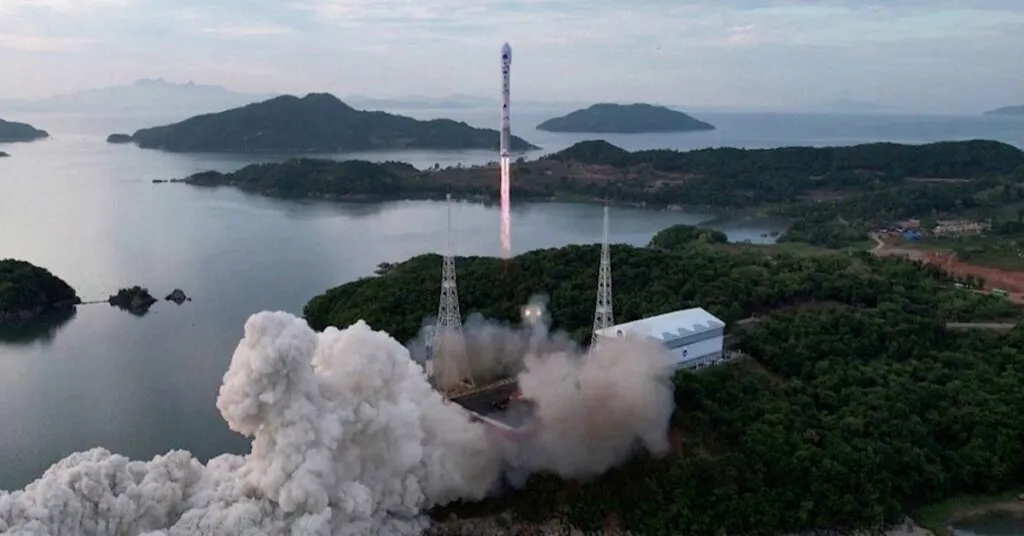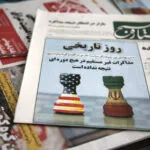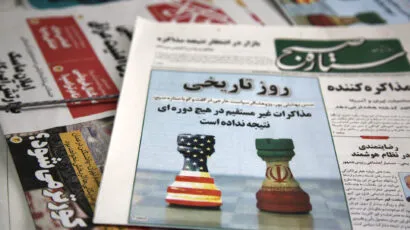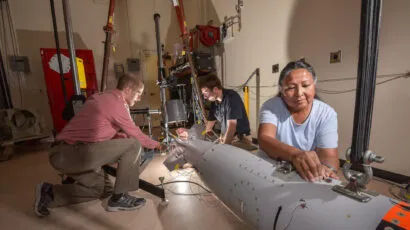Why North Korea’s new spy satellite could actually be a good thing
By Garrett Hinck | March 14, 2024
 North Korea's Chollima-1 rocket, carrying a military reconnaissance satellite, failed to reach orbit during its first flight in May 2023, shown here. A second attempt also failed, but a third attempt in November 2023 was successful. Credit: Gerry Doyle, CC BY-SA 4.0, via Wikimedia Commons
North Korea's Chollima-1 rocket, carrying a military reconnaissance satellite, failed to reach orbit during its first flight in May 2023, shown here. A second attempt also failed, but a third attempt in November 2023 was successful. Credit: Gerry Doyle, CC BY-SA 4.0, via Wikimedia Commons
North Korea’s November 22 launch of its first reconnaissance satellite may not be as destabilizing as the United States and many analysts say. The launch is probably not a cover for testing new missile technologies, but it is a step toward space-based reconnaissance for the Kim regime. Such a capability could modestly enhance North Korea’s plans for early use of nuclear capabilities if war breaks out on the Korean Peninsula, but it also could serve two roles that enhance stability on the Korean Peninsula: greater situational awareness and the ability to independently monitor agreements such as arms control if pursued in the future.
The negative impacts of North Korean satellites—in terms of missile development and sanctions violations as well as the cancellation of a military cooperation agreement between North and South Korea—are relatively minor. The potential upsides that these satellites may offer down the road are more significant. Moreover, examining these possibilities is a first step toward reconceptualizing North Korea from a proliferation problem to a deterrence problem that can be addressed through military postures, diplomatic signaling, and perhaps eventually arms control. With some experts warning that the situation on the Korean Peninsula today is more perilous than at any other time since 1950, and South Korea and the United States currently conducting annual joint military exercises involving twice as many troops as last year, a strategic reappraisal is sorely needed.
Missile development. The claim that North Korea uses satellite launches as a cover for its ballistic missile program is true, but this applies mostly to launches prior to 2023. Before 2017, launches of North Korea’s first satellites also served as a cover for tests of the Taepodong-2 intercontinental ballistic missile (ICBM).
In 2022, North Korea conducted two launches, on February 27 and March 5, that it claimed contributed to development of a reconnaissance satellite by briefly lofting sensors and data transmitters to test their performance. However, the Pentagon reported that the launches were the first tests of the new Hwasong-17 ICBM system, although not lofted enough to demonstrate ICBM range. Analysts argued that these initial tests likely served to evaluate the performance of the missile’s engines, and potentially to also test satellite capabilities as North Korea claimed. Describing the launches as satellite tests enabled North Korea to probe the moratorium on ICBM tests that it had followed since 2017.
However, the March 2022 test was followed by seven overt launches of ICBMs, including a Hwasong-17 launch in March 2023 that analysts believe marked the new ICBM’s deployment. North Korea described it as a “launching drill” rather than a test. Of the five ICBM tests that North Korea conducted in 2023, all were publicly claimed as such by North Korean state media and served to test not just the Hwasong-17 but also the newer Hwasong-18, which is solid-fueled and has even greater range. If North Korea wanted to test an ICBM, it would do so openly, as it did only three weeks after the successful satellite launch in November by testing the Hwasong-18 on December 19.
Citing the launches as a violation of UN Security Council resolutions that call for North Korea to abandon its ballistic missile program serves mainly to provide continued justification for sanctions enforcement. But the dozens of missile tests and launches in recent years suggest that both the resolutions and the sanctions have had little effect at stopping North Korean advances in missile technology. The deepening relationship between North Korea and Russia will further aid Pyongyang’s missile and space programs, making sanctions even less effective. Of course, it is worthwhile for diplomats to emphasize the legal bases of sanctions enforcement, but for analysts evaluating the military situation, there is nothing new or significant about these sanctions violations.
Stabilizing effects. The capabilities that a reconnaissance satellite offers to North Korea may serve as enablers of a more stable situation, even though reconnaissance capabilities contribute to North Korea’s military strategy. The ability to detect and monitor military activities in North Korea’s vicinity can enable offensive strategies by enhancing targeting and damage assessment. But it can also enhance stability by providing greater awareness of the operating environment. Official statements have consistently emphasized a goal of “real-time information,” which could enable North Korean officials to track US and South Korean forces in and around the Korean peninsula.
Although the resolution available to the first wave of satellites is likely modest in capability and may not enable North Korea to specifically identify aircraft or missile types, it could detect heightened levels of activity at bases that might be involved a conflict. For example, North Korea claimed that it imaged the USS Carl Vinson when the Navy nuclear-powered aircraft carrier was docked in Busan, and also captured images of Anderson Air Force base in Guam. There is not yet reliable evidence that the North’s satellite has a working imaging capability, but it did recently maneuver itself to a new orbit, suggesting that it remains functional and controlled from Pyongyang.
These capabilities could become potentially stabilizing if they give North Korea greater situational awareness and reduce fears of a surprise attack. These fears are likely to be significant in Pyongyang because of US and South Korean plans for conventional counterforce attacks in the event of a conflict. Allowing North Korea to more reliably identify what is an exercise and not a preemptive strike could help avert pressures for early nuclear use.
Another stabilizing effect could come from reconnaissance satellites if North Korea were to use them to verify certain confidence-building measures, like limits on US-South Korean military exercises or, eventually, arms control agreements for the Korean Peninsula. During the Cold War, reconnaissance satellites were crucial components of the “national technical means” that enabled the United States and the Soviet Union to have confidence in the verification of treaties lacking provisions for on-site inspections, such as the Anti-Ballistic Missile Treaty and the Strategic Arms Limitation treaties. Reconnaissance satellites, like those launched by the CORONA and HEXAGON programs, had enormous value for US intelligence. Satellites helped the US develop a much clearer picture of the Soviet Union’s military, which helped reduce inflated threat assessments. The data that satellites collected helped disprove the “missile gap” and later an “anti-ballistic missile gap.” In contrast, prior means of imagery intelligence, such as overflights by U-2 spy planes, provoked tensions and eventually proved vulnerable to air defenses, which created the potential for hostage crises.
While North Korea could likely obtain satellite photography from other sources, such as China or Russia, or even from commercial satellite firms, it would be unlikely to rely on these sources alone, especially to verify an agreement. Satellite reconnaissance complements North Korea’s other intelligence capabilities, which likely include networks of human agents as well as cyber and signals intelligence efforts. The advantage of satellites over other forms of intelligence collection is that they are reliable, difficult to hide from, and relatively immune to interference.
Arms control is still a very far-off possibility. But given that North Korea is not at all likely to give up its nuclear arsenal, pursuing mutual coexistence may at some point involve agreeements that, in order to be viable, must be verifiable by both sides. If a US-North Korean agreement were to include a clause protecting “national technical means” from deliberate interference, like all US-Soviet (and later Russian) arms control treaties did from the 1970s onward, it could give North Korea confidence in its ability to monitor compliance with any deal—for instance, by observing the presence of US nuclear-capable bombers at their bases. This would otherwise have to involve on-site inspections or other means that raise political and military issues. Reconnaissance satellites’ ability to contribute to verification without provoking conflict led President Jimmy Carter to describe them as “an important stabilizing factor in world affairs in the monitoring of arms control agreements … an immense contribution to the security of all nations.”
North and South Korean friction. In response to North Korea’s November satellite launch, South Korea formally suspended implementation of part of the 2018 Comprehensive Military Agreement with North Korea that established a no-fly-zone over their mutual border areas. This has been cited as a tit-for-tat move that shows increased tensions on the Korean Peninsula and a potential step that could increase the risk of encounters that lead to escalation. But the aircraft flights prohibited under the agreement would be primarily for surveillance purposes, and if reconnaissance satellites help build confidence, why isn’t that also true for aerial reconnaissance? The difference is that satellites are relatively immune from the friction that often characterizes aerial surveillance operations, where even accidental diversions can lead to losses of life. A more stable situation would be one in which both North and South Korea do not feel a need to mount aggressive aerial surveillance and instead can rely on satellites for reconnaissance. South Korea took a step toward this goal with the launch of its own reconnaissance satellite in December.
None of the analysis above endorses North Korea’s political goals or military strategies. But it is critical to recognize the potential benefits of certain military postures—even if they also enhance an adversary’s capabilities.
After the United States launched its first successful reconnaissance satellite in 1960, the Soviet Union protested, claiming that passes over its territory, even in space, constituted violations of sovereignty. Yet only a few years later, Soviet leaders indicated their tacit toleration of space-based reconnaissance, which laid the groundwork for major strategic arms control.
North Korea’s provocations have recently reached new heights, leading some analysts to warn that the situation is dangerously close to major conflict. Yet the last time tensions were this high, at the outset of the Trump administration, they were followed by an unprecedented attempt to reach common ground. If political conditions change, the United States and its allies should recognize how capabilities such as reconnaissance satellites enable agreements that could create more lasting stability on the Korean Peninsula. In the meantime, as US goals shift from nonproliferation to deterring North Korean nuclear use, analysts should consider how to incentivize a more stable military posture in Pyongyang. Noting the positive benefits of satellites could be a part of that. North Korea has said it plans to launch three more reconnaissance satellites this year. Multiple satellites in orbit would be necessary for the kind of real-time information that Pyongyang is after. Whether the current generation of satellites can provide that function is still unclear. However, demonstrating a capability to reliably launch satellites and maintain them in orbit could be a start toward a North Korea that has less fear of surprise and a greater capacity for cooperation.
Together, we make the world safer.
The Bulletin elevates expert voices above the noise. But as an independent nonprofit organization, our operations depend on the support of readers like you. Help us continue to deliver quality journalism that holds leaders accountable. Your support of our work at any level is important. In return, we promise our coverage will be understandable, influential, vigilant, solution-oriented, and fair-minded. Together we can make a difference.
Keywords: North Korea, reconnaissance satellite, verification
Topics: Nuclear Weapons, Opinion, Voices of Tomorrow
















Garrett Hinck’s comments are interesting, but not entirely relevant for one important reason: Hinck assumes that the military leadership of the DPRK, including and especially Kim Jong Un, are rational actors.
Being a Ukrainian citizen, my perspective may be biased, but apparently Pyonyang, Moscow and Beijing are getting ready for “just another” war. As the other user commented, the ruling paties there are doubtfully rational in their actions.